Write Picture Books Like the PROs – Create a Rock-Solid PREMISE first! • by Natascha Biebow
The art of writing apicture book is deceptively difficult. (It can be tempting to take a good long nap when you're stuck or in need of inspiration and fortitude when submitting . . .)
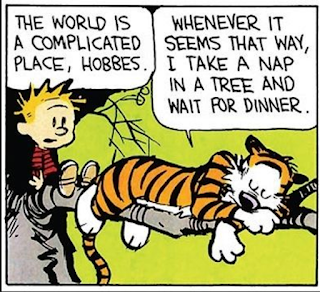 Summed up perfectly in this cartoon by Calvin and Hobbes by Bill Waterson
Summed up perfectly in this cartoon by Calvin and Hobbes by Bill Waterson
Here's why:
Most picture books start with an idea.
IDEA – the initial inspiration for thestory. The reason why the book is being written.
Yay! An idea is top-notch. Now, you can dive right in and write yourpicture book. You've made a good start, you might argue<span style="font-family: trebuchet;">@font-face {font-family:"Cambria Math"; panose-1:2 4 5 3 5 4 6 3 2 4; mso-font-charset:0; mso-generic-font-family:roman; mso-font-pitch:variable; mso-font-signature:-536870145 1107305727 0 0 415 0;}@font-face {font-family:Calibri; panose-1:2 15 5 2 2 2 4 3 2 4; mso-font-charset:0; mso-generic-font-family:swiss; mso-font-pitch:variable; mso-font-signature:-536859905 -1073732485 9 0 511 0;}@font-face {font-family:"Trebuchet MS"; panose-1:2 11 6 3 2 2 2 2 2 4; mso-font-charset:0; mso-generic-font-family:swiss; mso-font-pitch:variable; mso-font-signature:647 0 0 0 159 0;}p.MsoNormal, li.MsoNormal, div.MsoNormal {mso-style-unhide:no; mso-style-qformat:yes; mso-style-parent:""; margin:0cm; mso-pagination:widow-orphan; font-size:12.0pt; font-family:"Calibri",sans-serif; mso-ascii-font-family:Calibri; mso-ascii-theme-font:minor-latin; mso-fareast-font-family:Calibri; mso-fareast-theme-font:minor-latin; mso-hansi-font-family:Calibri; mso-hansi-theme-font:minor-latin; mso-bidi-font-family:"Times New Roman"; mso-bidi-theme-font:minor-bidi; mso-font-kerning:1.0pt; mso-ligatures:standardcontextual; mso-fareast-language:EN-US;}.MsoChpDefault {mso-style-type:export-only; mso-default-props:yes; font-family:"Calibri",sans-serif; mso-ascii-font-family:Calibri; mso-ascii-theme-font:minor-latin; mso-fareast-font-family:Calibri; mso-fareast-theme-font:minor-latin; mso-hansi-font-family:Calibri; mso-hansi-theme-font:minor-latin; mso-bidi-font-family:"Times New Roman"; mso-bidi-theme-font:minor-bidi; mso-fareast-language:EN-US;}div.WordSection1 {page:WordSection1;}</span>. Butwait . . . there's a catch – picture books written in this way often lack bothemotional resonance and cohesive narrative flow.This is because many ideas have been done asbooks before. This is also why you might be getting rejection letters that say yourbook 'feels too familiar' and 'doesn't stand out in the competitivemarketplace'.
More experienced creators will write out anoutline and figure out key elements in the PLOT.
PLOT – is just what happens in the story.
This is a great start too, however it stilloften leads to books that aren't compelling enough. Why? Because the authorhasn't addressed a key factor - WHY should anyone care about this story?
Waiting to plot out the book until afteryou've figured out what makes the book tick can save you a lot of time!
So how do you develop that initial idea intosomething that will make editors, agents, and most importantly, young readerstake notice?
You need a Rock-Solid Premise!
 If you figure out your rock-solid premise first, you'll stay on course and not go walkabout as you figure out
If you figure out your rock-solid premise first, you'll stay on course and not go walkabout as you figure out how to fix your picture book that just isn't resonating or selling. As inspired by Calvin and Hobbes (by Bill Waterson),
artfully balancing their way to the other side of the stream. Don't make the mistake of falling in or getting lost in the woods!
PREMISE — The unique way YOU are going to develop that idea into a compelling, marketable picture bookwith resonance and impact.
This is a KEY step that many picture bookcreators miss when developing their idea. By taking the time to work out asolid premise, you can take your picture book to the next level by making itunique, memorable and powerful.
To give you an idea of how this can work,let's look at a bestselling picture book that is celebrating 20 years:
DON'T LET THE PIGEON DRIVE THE BUS by MoWillems
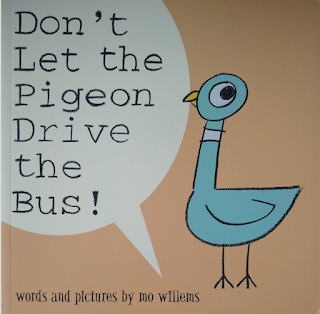
Premise: achild-like pigeon wants to drive the bus, but the driver has left the readerwith strict instructions to mind the bus and not let the pigeon drive it. Thepigeon begs, wheedles and negotiates, trying all the tactics that young readersmight recognize from when they are trying to get grown-ups to do what theywant. The pigeon gets increasingly frustrated and angry, butthe readers keep on telling him "NO!"
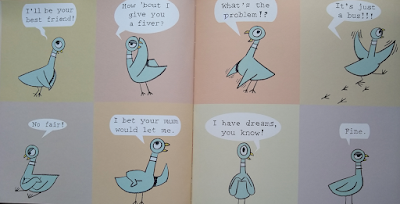 From Don't Let the Pigeon Drive the Bus! by Mo Willems
From Don't Let the Pigeon Drive the Bus! by Mo Willems
When the driver returns and thanks them at the end of the story, thepigeon is sad, but still hopeful. Now, he's dreaming bigger with his sights seton driving . . . a truck!
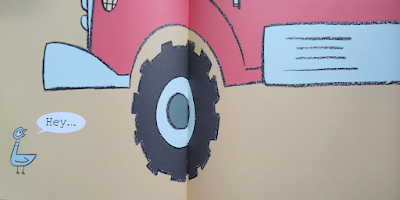 From Don't Let the Pigeon Drive the Bus! by Mo Willems
From Don't Let the Pigeon Drive the Bus! by Mo Willems
In aninterview on CBS Mornings,Mo Willems said, "I think of my audience, but I never think for myaudience."
In the firstbook of his bestselling series, the author places the child firmly in thedriver's seat. The interactive dialogue format itself encourages creativity andimagination. The book is something kids can play with. It is also a springboardfor imagining new adventures for the pigeon character.
The reason thispremise is so strong is that the role-reversal resonates with both children andadults alike. Willem's child-centred plot, character motivation and humour areseamlessly interwoven to create a very simple, but unique and compelling storythat resonates.
Crafting astrong PREMISE is a powerful (and often missed) pro skill. It is the coreconcept that gives your book a reason to exist. It's what takes an idea thatmany other writers may have had, and makes it uniquely yours. It takes craftand skill – and sometimes 'cooking time' – to develop a solid premise that willmake your book stand out in the competitive marketplace. It's well worthspending some time to consider your premise before you start writing.
_________________________________________________________________
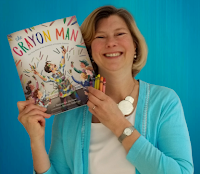 Natascha Biebow, MBE, Author, Editor and Mentor Want to know more? Take a deep-dive and learn howto develop a rock-solid premise and how it can empower you to create theperfect hook for your pitch and query letter here.
Natascha Biebow, MBE, Author, Editor and Mentor Want to know more? Take a deep-dive and learn howto develop a rock-solid premise and how it can empower you to create theperfect hook for your pitch and query letter here.
Natascha is the author of the award-winning The Crayon Man: The True Story of the Invention of Crayola Crayons, illustrated by Steven Salerno, winner of the Irma Black Award for Excellence in Children's Books, and selected as a best STEM Book 2020. Editor of numerous prize-winning books, she runs Blue Elephant Storyshaping, an editing, coaching and mentoring service aimed at empowering writers and illustrators to fine-tune their work pre-submission, and is the Editorial Director for Five Quills. Find out about her new picture book webinar courses! She is Co-Regional Advisor (Co-Chair) of SCBWI British Isles. Find her at www.nataschabiebow.com
<span style="font-family: trebuchet;">@font-face {font-family:"Cambria Math"; panose-1:2 4 5 3 5 4 6 3 2 4; mso-font-charset:0; mso-generic-font-family:roman; mso-font-pitch:variable; mso-font-signature:-536870145 1107305727 0 0 415 0;}@font-face {font-family:Calibri; panose-1:2 15 5 2 2 2 4 3 2 4; mso-font-charset:0; mso-generic-font-family:swiss; mso-font-pitch:variable; mso-font-signature:-536859905 -1073732485 9 0 511 0;}@font-face {font-family:"Trebuchet MS"; panose-1:2 11 6 3 2 2 2 2 2 4; mso-font-charset:0; mso-generic-font-family:swiss; mso-font-pitch:variable; mso-font-signature:647 0 0 0 159 0;}p.MsoNormal, li.MsoNormal, div.MsoNormal {mso-style-unhide:no; mso-style-qformat:yes; mso-style-parent:""; margin:0cm; mso-pagination:widow-orphan; font-size:12.0pt; font-family:"Calibri",sans-serif; mso-ascii-font-family:Calibri; mso-ascii-theme-font:minor-latin; mso-fareast-font-family:Calibri; mso-fareast-theme-font:minor-latin; mso-hansi-font-family:Calibri; mso-hansi-theme-font:minor-latin; mso-bidi-font-family:"Times New Roman"; mso-bidi-theme-font:minor-bidi; mso-font-kerning:1.0pt; mso-ligatures:standardcontextual; mso-fareast-language:EN-US;}a:link, span.MsoHyperlink {mso-style-priority:99; color:#0563C1; mso-themecolor:hyperlink; text-decoration:underline; text-underline:single;}a:visited, span.MsoHyperlinkFollowed {mso-style-noshow:yes; mso-style-priority:99; color:#954F72; mso-themecolor:followedhyperlink; text-decoration:underline; text-underline:single;}p.text-align-left, li.text-align-left, div.text-align-left {mso-style-name:text-align-left; mso-style-unhide:no; mso-margin-top-alt:auto; margin-right:0cm; mso-margin-bottom-alt:auto; margin-left:0cm; mso-pagination:widow-orphan; font-size:12.0pt; font-family:"Times New Roman",serif; mso-fareast-font-family:"Times New Roman";}p.text-align-center, li.text-align-center, div.text-align-center {mso-style-name:text-align-center; mso-style-unhide:no; mso-margin-top-alt:auto; margin-right:0cm; mso-margin-bottom-alt:auto; margin-left:0cm; mso-pagination:widow-orphan; font-size:12.0pt; font-family:"Times New Roman",serif; mso-fareast-font-family:"Times New Roman";}.MsoChpDefault {mso-style-type:export-only; mso-default-props:yes; font-family:"Calibri",sans-serif; mso-ascii-font-family:Calibri; mso-ascii-theme-font:minor-latin; mso-fareast-font-family:Calibri; mso-fareast-theme-font:minor-latin; mso-hansi-font-family:Calibri; mso-hansi-theme-font:minor-latin; mso-bidi-font-family:"Times New Roman"; mso-bidi-theme-font:minor-bidi; mso-fareast-language:EN-US;}div.WordSection1 {page:WordSection1;}</span>



